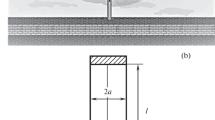Abstract
The exact solution of self-excited vibrations of a reservoir hydraulic fracture after stopping the hydraulic fracture fluid injection is obtained on the basis of the generalized hyperbolictype Perkins-Kern-Nordgren model of the development of vertical reservoir hydraulic fracture. The vibrations are excited by the rarefaction wave developed after stopping the injection. The solution obtained is used to estimate the height, the width, and the half-length of the reservoir hydraulic fracture on the basis of the field data of bottomhole pressure gauges by the time of stopping the hydraulic fracture fluid injection.
Similar content being viewed by others
References
N. E. Joukowsky, “Über den hydraulischen Stoss in Wasserleitungsro¨ hren [On the hydraulic hammer in water supply pipes],” Memoires de l’Academie Imperiale des Sciences de St.-Petersbourg, Ser. 8 9 (5), 1–71 (1900) [in German].
S. A. Khristianovich, Continuum Mechanics (Nauka, Moscow, 1981) [in Russian].
I. A. Charnyi, Unsteady Pipe Flow of a Real Fluid (GITTL,Moscow, Leningrad, 1951) [in Russian].
M. Kay, Practical Hydraulics, 2nd ed. (Taylor and Francis, 2008).
A. Tijsselin and A. Anderson, “Johannes von Kries and the History ofWater Hammer,” Journal of Hydraulic Engineering 133 (1), 1–8 (2007).
E. B. Wylie and V. L. Streeter, Fluid Transients in Systems (Prentice-Hall, Englewood Cliffs, N.J., 1993).
C. R. Holzhausen and R. P. Gooch, “Impedance of Hydraulic Fracture: Its Measurement and Use for Estimating Fracture Closure and Dimensions,” Paper SPE 13892 Presented at SPE/DOE Low Permeability Gas Reservoirs Symposium, Denver,May 19–22, 1985. DOI: https://doi.org/10.2118/13892-MS
T. W. Patzek and A. De, “Lossy Transmission Line Model of Hydrofractured Well Dynamics,” Journal of Petroleum Science and Engineering 25 (1–2), 59–77 (2000). DOI: https://doi.org/10.2118/46195-MS
R. W. Paige, L. R. Murray, and J. D. M. Roberts, “Field Application of Hydraulic Impedance Testing for FractureMeasurement,” SPE J. 10 (01), 6–12 (1995). DOI: https://doi.org/10.2118/26525-PA
J.N. Sneddon and D.S. Berry, The Classical Theory of Elasticity (Springer, Berlin etc., 1958; Fizmatgiz, Moscow, 1961).
M. A. Carey, S. Mondal, and M. M. Sharma, “Analysis of Water Hammer Signatures for Fracture Diagnostics,” Paper SPE-174866-MS Presented at the SPE Annual Technical Conference and Exhibition, Houston, Texas, September 28–30, 2015. DOI: http://dx.doi.org/10.2118/174866-MS
J. Iriarte, J. Merritt, and B. Kreyche, “UsingWater Hammer Characteristics as a Fracture Treatment Diagnostic,” Paper SPE-185087-MC Presented at the 2017 SPE Oklahoma City Oil and Gas Symposium, 27–31 March, Oklahoma City, Oklahoma, USA. DOI: https://doi.org/10.2118/185087-MS
A. M. Il’yasov and G. T. Bulgakova, “Quasi-one-dimensional Model of the Hyperbolic Type of Reservoir Hydraulic Fracturing,” Vest. Sam. Gos. Tekhn. Un-ta Ser. Fiz.-Mat. Nauki 20 (4), 739–754 (2016). DOI: http://dx.doi.org/10.14498/vsgtu1522
T. K. Perkins and L. R. Kern, “Width of Hydraulic Fractures,” Journal of Petroleum Technology 13 (4), 937949 (1961).
R. P. Nordgren, “Propagation of a Vertical Hydraulic Fracture,” Society of Petroleum Engineers J. 12 (4), 306–314 (1972).
I. E. Idel’chik, Handbook on Hydraulic Resistances (Mashinostroenie,Moscow, 1992) [in Russian].
O. E. Ivashnev and N. N. Smirnov, “Formation of a Hydraulic Fracture in a Porous Medium,” Vestn. MGU. Matematika,Mekhanika 6, 28–36 (2003).
F. I. Kotyakhov, Physics of Gas and Oil Reservoirs (Nedra, Moscow, 1977) [in Russian].
P. Malkowski and L. Ostrowski, “The Methodology for the Young Modulus Derivation for Rocks and Its Value,” in: Proc. ISRM European Rock Mechanics Symposium—EUROCK, June 2–22, 2017, Ostrava, 191 (Elsevier Ltd, 2017), p. 134–141.
A.M. Il’yasov, “Estimation of the Strength of a Cement Ring Adjacent to the Borehole of a ProductionWell,” Zh. Prikl.Mekh. Tekh. Fiz. 58 (1), 210–217 (2017).
Yu. N. Rabotnov, Mechanics of Deformed Solid Body (Nauka, Moscow, 1988) [in Russian].
M. J. Economides and T. Martin, Modern Fracturing. Enhancing Natural Gas Production (Energy Tribune Publishing Inc., Houston, TX. USA, 2007).
A. N. Tikhonov and A. A. Samarskii, Equations of Mathematical Physics (Nauka, Moscow, 1977) [in Russian].
M. J. Economides and K. G. Nolte, Reservoir Stimulation (Wiley, NY and Chichester, 2000).
P. I. Nigmatulin, Fundamentals of Mechanics of Heterogeneous Media (Nauka, Moscow, 1978) [in Russian].
Author information
Authors and Affiliations
Corresponding author
Additional information
Original Russian Text © V.A. Baikov, G.T. Bulgakova, A.M. Il’yasov, D.V. Kashapov, 2018, published in Izvestiya Rossiiskoi Akademii Nauk, Mekhanika Zhidkosti i Gaza, 2018, No. 5, pp. 64–75.
Rights and permissions
About this article
Cite this article
Baikov, V.A., Bulgakova, G.T., Il’yasov, A.M. et al. Estimation of the Geometric Parameters of a Reservoir Hydraulic Fracture. Fluid Dyn 53, 642–653 (2018). https://doi.org/10.1134/S0015462818050038
Received:
Published:
Issue Date:
DOI: https://doi.org/10.1134/S0015462818050038



